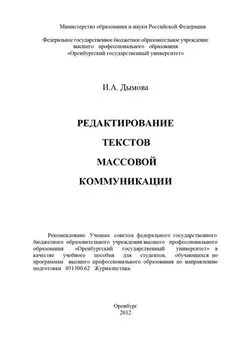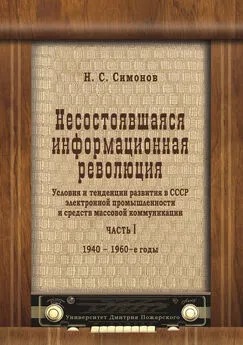Ричард Харрис - Психология массовых коммуникаций
- Название:Психология массовых коммуникаций
- Автор:
- Жанр:
- Издательство:2002
- Год:2002
- Город:Санкт-Петербург
- ISBN:5-93878-033-0
- Рейтинг:
- Избранное:Добавить в избранное
-
Отзывы:
-
Ваша оценка:
Ричард Харрис - Психология массовых коммуникаций краткое содержание
«Предупреждён – значит вооружён». Такой эпиграф мог бы открывать эту книгу. И не имеет значения, кто возьмёт её в руки. Специалист почерпнёт в ней новые приёмы и подходы к анализу стратегии и тактики СМИ. Любознательный обыватель научится обеспечивать собственную информационную безопасность.
Кроме того картина информационного ландшафта современного общества от предвыборного управления массовым сознанием до рекламы памперсов оказывается настолько захватывающей, что однажды начав читать эту книгу, вы уже не оставите её недочитанной.
Психология массовых коммуникаций - читать онлайн бесплатно полную версию (весь текст целиком)
Интервал:
Закладка:
Larson, J. F, McAnany, E. G., Storey, J. D. (1986). News of Latin America on network television, 1972–1981: A northern perspective on the southern hemisphere. Critical Studies in Mass Communication, 3, 169–183.
Larson, M. S. (1989). Interaction between siblings in prime time television families. Journal of Broadcasting and Electronic Media, 33(3). 305–315.
Lasisi, M. J., Onyehalu, A. S. (1992). Cultural influences of a reading text on the concept formation of second-language learners of two Nigerian ethnic groups. In: R. J. Harris (Ed.). Cognitive processing in bilinguals (p. 459–471). Amsterdam: EIsevier/North Holland.
Lasswell, H. D. (1927). Propaganda technique in the world war. New York: Knopf.
Lasswell, H. D. (1935). World politics and personal insecurity: A contribution to political psychiatry. New York: McGraw-Hill.
Lau. R. R. (1986). Political schemata, candidate evaluations, and voting behavior. In: R. R. Lau D. O. Sears (Eds.). Political cognition (p. 95–126). Hillsdale, NJ: Lawrence Eribaum Associates.
Lawlor, S. D., Sparkcs, A., Wood, J. (1994, July). When Lawrence came out: Taking the funnies seriously. Paper presented at Annual Conference of the International Communication Association, Sydney, Australia.
Lazarsfeld, P. F. (1941). Remarks on administrative and critical communications research. Studies in Philosophy of Social Science, 9, 2–16.
Lazarsfeld, P. F., Berelson, В ., Gaudet, H. (1948). The people's choice. New York: Columbia University Press.
Leaviit, L. A., Fox, N. A. (Eds.). (1993). The psychological effects of war and violence on children. Hillsdale, NJ: Lawrence Eribaum Associates.
Lee. С . С . (1980). Media imperialism reconsidered. Beverly Hills, CA: Sage.
Lee. M. A., Solomon, N. (1991). Unreliable sources: A guide to detecting bias in news media. New York: Carol Publishing Group.
Lefkowitz. M. M., Eron, L. D., Walder, L. D., Hues-man a, L. R. (1977). Growing up to be violent: A longitudinal study of the development of aggression. New York: Pergamon.
Lemar, J. (1977). Women and blacks on prime time television. Journal of Communication, 27, 70–80.
Lever, J., Wheeler, S. (1993). Mass media and the experience of sport. Communication Research, 20, 125–143.
Levin. J. P., Gaeth, G. J. (1988). How consumers are affected by the framing of attribute information before and after consuming the product. Journal of Consumer Research, 15, 374–378.
Levy. M. R. (1980). Program playback preferences in VCR households. Journal of Broadcasting, 24, 327–336.
Levy, M. R. (1982). Watching TV news as para-social interaction. In: G. Gumpert R. Cathcart (Eds.). Inter/media (2nd ed., p 177–187). New York: Oxford University Press.
Levy; M. R. (1987). Some problems of VCR research. American Behavioral Scientist, 30, 461–470.
Levy, M. R., Windahl. S. (1984). Audience activity and gratifications: A conceptual clarification and exploration. Communication Research, II, 51–78.
Lewy, G. (1978, February). Vietnam: New light on the question of American guilt. Commentary, 65, 29–49.
Leyens, J., C'amino, L., Parke, R., Berkowitz, L. (1975). The effects of movie violence on aggression in a field setting as a function of group dominance and cohesion. Journal of Personality and Social Psychology, 32, 346–360.
Liebert, R. M., Sprafkin, J. (1988). The early window: Effects of television on children and youth (3rd ed.). New York: Pergamon.
Liebes, T, Livingstone, S. M. (1992). Mothers and lovers: Managing women's role conflicts in American and British soap operas. In: J. G. Blumler, J. M. McLeod, К . Е . Rosengren (Eds.). Comparatively speaking: Communication and culture across space and time (p. 94–120). Newbury Park, CA: Sage.
Lillington, K. (1998, March). Breaking the bounds of the page. The Guardian. (Reprinted in: World Press Review. March, 1998, p. 46–47.) Lindlof, T. R., Shatzer, M. J. (1990). VCR usage in the American family. In: J. Bryant (Ed.). Television and the American family (p. 89–109). Hillsdale, NJ: Lawrence Eribaum Associates.
Linz. D. (1985). Sexual violence in the mass media: Effects on male viewers and implications for society. Unpublished doctoral dissertation. University of Wisconsin, Madison.
Linz. D., Donnerstein, E. (1988). The methods and merits of pornography research. Journal of Communication. 38(2), 180–184.
Linz, D., Donnerstein, E. (1992, September 30). Research can help us explain violence and pornography. Chronicle of Higher Education, p. B3–B4.
Linz, D., Donnerstein, E., Adams, S. M. (1989). Physiological desensitization and judgments about female victims of violence. Human Communication Research, 15, 509–522.
Linz, D., Donnerstein, E., Bross, M., Chapin, M. (1986). Mitigating the influence of violence on television and sexual violence in the media. In: R. Blanchard (Ed.). Advances in the study of aggression (Vol. 2, p. 165–194). Orlando, FL: Academic Press.
Linz. D., Donnerstein, E., Penrod, S. (1984). The effects of multiple exposures to filmed violence against women. Journal of Communication, 34(3), 130–147.
Linz, D., Donnerstein, E., Penrod, S. (1987). The findings and recommendations of the Attorney General's Commission on Pornography: Do the psychological "facts" fit the political fury? American Psychologist, 42, 946–953.
Linz, D., Fuson, I. A., Donnerstein, E. (1990). Mitigating the negative effects of sexually violent mass communications through preexposure briefings. Communication Research, 17, 641–674.
Linz, D., Malamuth, N. (1993). Pornography. Newbury Park, CA: Sage.
Linz, D., Turner, C. W, Hesse. B. W, Penrod, S. D. (1984). Bases of liability for injuries produced by media portrayals of violent pornography. In: N. M. Malamuth E. Donnerstein (Eds.). Pornography and sexual aggression (p. 277–304). Orlando, FL: Academic Press.
Loftus, E. F, Burns, Т . Е . (1982). Mental shock can produce retrograde amnesia. Memory Cognition, 10, 318–323.
"Lolita in Japan". (1997, April 6). Manhattan Mercury, p. A7.
Long, D. L., Graesser, A. C. (1988). Wit and humor in discourse processing. Discourse Processes, 11, 35–60.
Longford, L. (Ed.). (1972). Pornography: The Longford Report. London: Coronet.
Longmore, P. K. (1985, Summer). Screening stereotypes: Images of disabled people. Social Policy, p. 31–37.
Lovaas, O. L. (1961). Effect of exposure to symbolic aggression on aggressive behavior. Child Development, 32, 37–44.
Lovdahl, L. T. (1989). Sex role messages in television commercials: An update. Sex Roles. 21, 715–724.
Lowery, S., DeFleur, M. L. (1983). Milestones in mass communication research. New York: Longman. Lowry, D. T, Love, G., Kirby. M. (1981). Sex on the soap operas: Patterns of intimacy. Journal of Communication, 31, 90–96.
Lowry. D. T, Towles. D. E. (1989). Soap opera portrayals of sex, contraception, and sexually transmitted diseases. Journal of Communication, 39(2), 76–83.
Loy, J. W., McPherson, B. D., Kenyon, G. (1978). Sport and social systems: A guide to the analysis, problems, and literature. Reading, MA: Addison-Wesley.
Lozano, E. (1992). The force of myth on popular narratives: The case of melodramatic serials. Communication Theory, 2, 207–220.
Luebke, B. (1989). Out of focus: Images of women and men in newspaper photographs. Sex Roles, 20(3/4), 121–133.
Luepker, R. V, Murray, D. M.. Jacobs, D. R., Jr., Mittelmank, M. В ., Bracht, N., Carlaw, R., Crow, R., Elmer. P., Finnegan, J., Folsom, A. R. (1994). Community education for cardiovascular disease prevention: Risk factor changes in the Minnesota Heart Health Program. American Journal of Public Health, 84, 1383–1393.
Luke, C. (1987). Television discourse and schema theory: Toward a cognitive model of information processing. In: M. E. Manley-Casimir C. Luke (Eds.). Children and television: A challenge for education (p. 76–107). New York: Praeger.
Lull, J. (Ed.). (1988). World families watch television. Newbury Park, CA: Sage.
Lyons, J. S., Anderson, R. L., Larson, D. B. (1994). A systematic review of the effects of aggressive and nonaggressive pornography. In: D. Zillmann, J. Bryant, A. C. Huston (Eds.). Media, family, and children: Social, scientific, psychodynamic, and clinical perspectives (p. 271–310). Hillsdale, NJ: Lawrence Eribaum Associates.
Macbeth, T. M. (1996). Indirect effects of television: Creativity, persistence, school achievement, and participation in other activities. In: T. M. Macbeth (Ed.). Tuning in to young viewers: Social science perspectives on television (p. 149–219). Thousand Oaks, CA: Sage.
MacFarland, D. T. (1990). Contemporary radio programming strategies. Hillsdale, NJ: Lawrence Eribaum Associates.
Madden, T. J., Weinberger, M. G. (1982). The effects of humor on attention in magazine advertising. Journal of Advertising. 11(3'). 8–14.
Madden. T. J., Weinberger, M. G. (1984). Humor in advertising: A practitioner view. Journal of Advertising Research, 24(4), 23–29.
Maibach, E., Flora, J. A. (1993). Symbolic modeling and cognitive rehearsal: Using video to promote AIDS prevention self-efficacy. Communication Research, 20, 517–545.
Maibach, E., Parrott, R. L. (1995). Designing health messages. Thousand Oaks, CA: Sage. Maier, S. (1994, January). India's awakening? World Press Review, p. 29.
Malamuth, N. M. (1981). Rape fantasies as a function of exposure to violent sexual stimuli. Archives of Sexual Behavior. 10, 33–47.
Malamuth, N. M. (1984). Aggression against women: Cultural and individual causes. In: N. M. Malamuth E. Donnerstein (Eds.). Pornography and sexual aggression (p. 19–52). Orlando, FL: Academic Press.
Malamuth, N. M., Check, J. V P. (1980 a). Penile tumescence and perceptual responses to rape as a function of victim's perceived reactions. Journal of Applied Social Psychology. 10 528–547.
Malamuth, N. M., Check, J. V. P. (1980 b). Sexual arousal to rape and consenting depictions: The importance of the woman's arousal. Journal of Abnormal Psychology, X9, 763–766.
Malamuth, N. M., Check, J. V. P (1983). Sexual arousal to rape depictions: Individual differences. Jour-nut of Abnormal Psychology, 92, 55–67.
Malamuth. N. M., Check. J. V. P., Briere, J. (1986). Sexual arousal in response to aggression: Ideological, aggressive, and sexual correlates. Journal of Personality and Social Psychology, 50, 330–340.
Malamuth. N. M.. Feshbach, S., Heim, M. (1980). Ethical issues and exposure to rape stimuli: A reply to Sherif. Journal of Personality and Social Psychology, 38, 413–415.
Malamuth, N. M., Haber, S.. Feshbach, S. (1980).« Testing hypotheses regarding rape: Exposure to sexual violence, sex differences, and the "normality" of rapists. Journal of Research in Personality, 14, 121–137.
Malamuth, N. M., Heim, M., Feshbach, S. (1980). Sexual responsiveness of college students to rape depictions: Inhibitory and disinhibitory effects. Journal of Personality and Social Psychology. ЗЯ , 399–408.
Malamuth, N. M., Spinner, B. (1980). A longitudinal content analysis of sexual violence in the best selling erotica magazines. Journal of Sex Research, 16, 226–237.
Mankiewicz, F., Swerdlow, J. (1978). Remote control: Television and the manipiilation of American life. New York: Ballantine.
Manley-Casimir, M. E., Luke, C. (Eds.). (1987). Children and television. A challenge for education. New York: Praeger.
Manrai, L. Л ., Gardner, M. P. (1992). Consumer processing of social ideas advertising: A conceptual model. Advances in Consumer Research, 19, 15–20.
Mares, M.-L. (1998). Children's use of VCRs. The Annals of the American Academy of Political and Social Science. 557, 120–131.
Читать дальшеИнтервал:
Закладка:










